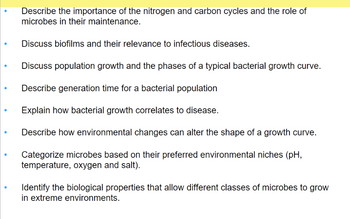
Human Anatomy & Physiology (11th Edition)
11th Edition
ISBN: 9780134580999
Author: Elaine N. Marieb, Katja N. Hoehn
Publisher: PEARSON
expand_more
expand_more
format_list_bulleted
Concept explainers
Question

Transcribed Image Text:Describe the importance of the nitrogen and carbon cycles and the role of
microbes in their maintenance.
Discuss biofilms and their relevance to infectious diseases.
Discuss population growth and the phases of a typical bacterial growth curve.
Describe generation time for a bacterial population
Explain how bacterial growth correlates to disease.
Describe how environmental changes can alter the shape of a growth curve.
Categorize microbes based on their preferred environmental niches (pH,
temperature, oxygen and salt).
Identify the biological properties that allow different classes of microbes to grow
in extreme environments.
Expert Solution
arrow_forward
Step 1: Biogeochemical cycles
Note:- Sorry, since you have posted multiple questions, as per the honor code, we will solve the first one for you. Please repost the rest parts separately. Thank you!
Inorganic and organic substances together make up the biosphere. The movement of these organic and inorganic substances between the biological and non-biological components of the biosphere in a cyclic manner is known as the biochemical cycle.
Some examples of the biochemical cycle include the water cycle, carbon cycle, nitrogen cycle, and phosphorous cycle.
Step by stepSolved in 4 steps

Knowledge Booster
Learn more about
Need a deep-dive on the concept behind this application? Look no further. Learn more about this topic, biology and related others by exploring similar questions and additional content below.Similar questions
- تشمل ملوثات المياه: Water pollutants includes.. A) Pathogens, Greenhouse gases, Heavy metals B) Pathogens, Greenhouse gases, Chemicals C) Pathogens, Chemicals, Heavy metals D) Pathogens, Greenhouse gases, Organic matterarrow_forwardLabel each part (a, b, c, d and e) of the energy flow and chemical recycling in ecosystems illustrated below.arrow_forwardDescribe how waste management will be different in a sustainable future.arrow_forward
- Describe what leads to ozone depletion and the consequences of having an ozone hole in our atmosphere.arrow_forwardDescribe at least three mechanisms microbes have evolved to adapt to the low nutrient conditions found in the open oceanarrow_forwardExplain the different factors that contribute to environmental impact affecting human activities.arrow_forward
- Draw out the Nitrogen cycle; label nitrogen fixation, decomposers, ammonium, nitrates, uptake by plants, nitrogen in the atmosphere, detritus.arrow_forwardThe biological pump in the ocean O A) is independent of the atmosphere. O B) moves carbon to deeper waters. O C) moves carbon toward the surface. D) circulates oxygen.arrow_forwardDiscuss the issue of the landfills, including advantages and disadvantages.arrow_forward
arrow_back_ios
SEE MORE QUESTIONS
arrow_forward_ios
Recommended textbooks for you
 Human Anatomy & Physiology (11th Edition)BiologyISBN:9780134580999Author:Elaine N. Marieb, Katja N. HoehnPublisher:PEARSON
Human Anatomy & Physiology (11th Edition)BiologyISBN:9780134580999Author:Elaine N. Marieb, Katja N. HoehnPublisher:PEARSON Biology 2eBiologyISBN:9781947172517Author:Matthew Douglas, Jung Choi, Mary Ann ClarkPublisher:OpenStax
Biology 2eBiologyISBN:9781947172517Author:Matthew Douglas, Jung Choi, Mary Ann ClarkPublisher:OpenStax Anatomy & PhysiologyBiologyISBN:9781259398629Author:McKinley, Michael P., O'loughlin, Valerie Dean, Bidle, Theresa StouterPublisher:Mcgraw Hill Education,
Anatomy & PhysiologyBiologyISBN:9781259398629Author:McKinley, Michael P., O'loughlin, Valerie Dean, Bidle, Theresa StouterPublisher:Mcgraw Hill Education, Molecular Biology of the Cell (Sixth Edition)BiologyISBN:9780815344322Author:Bruce Alberts, Alexander D. Johnson, Julian Lewis, David Morgan, Martin Raff, Keith Roberts, Peter WalterPublisher:W. W. Norton & Company
Molecular Biology of the Cell (Sixth Edition)BiologyISBN:9780815344322Author:Bruce Alberts, Alexander D. Johnson, Julian Lewis, David Morgan, Martin Raff, Keith Roberts, Peter WalterPublisher:W. W. Norton & Company Laboratory Manual For Human Anatomy & PhysiologyBiologyISBN:9781260159363Author:Martin, Terry R., Prentice-craver, CynthiaPublisher:McGraw-Hill Publishing Co.
Laboratory Manual For Human Anatomy & PhysiologyBiologyISBN:9781260159363Author:Martin, Terry R., Prentice-craver, CynthiaPublisher:McGraw-Hill Publishing Co. Inquiry Into Life (16th Edition)BiologyISBN:9781260231700Author:Sylvia S. Mader, Michael WindelspechtPublisher:McGraw Hill Education
Inquiry Into Life (16th Edition)BiologyISBN:9781260231700Author:Sylvia S. Mader, Michael WindelspechtPublisher:McGraw Hill Education

Human Anatomy & Physiology (11th Edition)
Biology
ISBN:9780134580999
Author:Elaine N. Marieb, Katja N. Hoehn
Publisher:PEARSON

Biology 2e
Biology
ISBN:9781947172517
Author:Matthew Douglas, Jung Choi, Mary Ann Clark
Publisher:OpenStax

Anatomy & Physiology
Biology
ISBN:9781259398629
Author:McKinley, Michael P., O'loughlin, Valerie Dean, Bidle, Theresa Stouter
Publisher:Mcgraw Hill Education,

Molecular Biology of the Cell (Sixth Edition)
Biology
ISBN:9780815344322
Author:Bruce Alberts, Alexander D. Johnson, Julian Lewis, David Morgan, Martin Raff, Keith Roberts, Peter Walter
Publisher:W. W. Norton & Company

Laboratory Manual For Human Anatomy & Physiology
Biology
ISBN:9781260159363
Author:Martin, Terry R., Prentice-craver, Cynthia
Publisher:McGraw-Hill Publishing Co.

Inquiry Into Life (16th Edition)
Biology
ISBN:9781260231700
Author:Sylvia S. Mader, Michael Windelspecht
Publisher:McGraw Hill Education